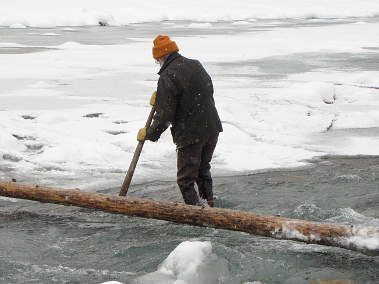
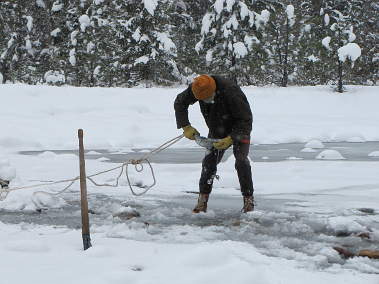
Whoah! Winter arrived a bit early, with the temperature dropping to -20F and snow piling up steadily. The last couple of years, our neighbors Steve Kloetzel and Andrea Morgan built a bridge across the river down by their house, and we waited for the snow and ice to build up a little on the river and then I chucked a few poles across and hoped the snow and ice would build up enough to make another bridge. This year I decided to get ahead of the game. I had three long logs from trees I had felled last year -- logs I was planning on using to put bridges across the river last year but didn't get done. I put the tractor in four wheel drive, suspended a log lengthwise from the roll bar and the bucket, and gingerly wuffled my way through the snow down to the river, where I deposited the log. I did the same with a second log, and then took the third upriver to another narrow spot. By fortuitous circumstances, Andrea was bored and called and said she'd love to come help make a bridge. So the next day she showed up with a light chainsaw and another peavey, and we loaded the tractor bucket with chains and ropes, and drove the tractor as close as I dared. I couldn't get as close to the river as the day before because the steep uphill places out of the floodplain were now smooth and hard with slippery snow and ice. So we ploughed on foot through the snow to the riverbank.
I had the logs pretty much lined up on the river bank. The general plan was to hook a chain to one end, take the chain across the river with a come-along, and winch the logs over. Simple enough in early fall when the river is down and it's not really cold and there isn't a foot of snow. Fortunately, the river was still down -- it stays low all winter; indeed, that is when it is lowest. But it was below freezing, and much of the river bed was covered with anchor ice. I used a peavey as a third leg and worked my way, carrying a long rope and a come-along with me. I tied the rope around a log buried in a log-jam, then hooked the come-along to the rope. On my second trip, I dragged a chain behind me and Andrea tied the other end off to the end of the log.
I worked the come-along while Andrea maneuvered and levered the tail of the log. It slid like clockwork down to the river, didn't get too hung up, and in no time we had it across. However, it was barely long enough, and the bottom of it was dragging in the water. We rolled a big log down to the edge of the bank and using a peavey as an inclined plane, slid the bridge log up onto the log abutment.
 |
 |
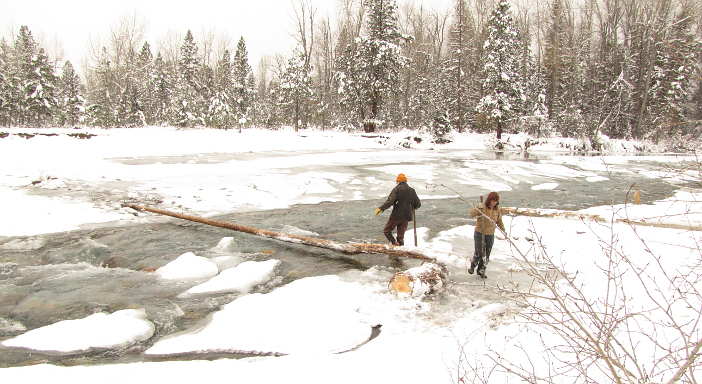 |
Surprisingly, I was still warm. Thank the guy who invented neoprene waders, and sheep for wool socks and good mittens. And the peavey, my third leg while crossing.
We needed an abutment on the far side as well, as the end of the log was down in the water overflowing along the gravel bar on the far side of the river. We were at the narrowest spot around, but because of anchor-ice build-up on the river bottom and surface ice build-up around rocks, the water would back up and overflow in other areas; in this case, most of the gravel bar. However, I figured we might need two of us to get a large enough log down to the river. Andrea's boots weren't high enough to wade across, so that would have to wait.
I ferried the chain back across to Andrea, who hooked it on the second log. Back on the other side, I hooked up the come-along and started winching. The log slid down into the river and the chain went slack, came loose, and slid off the end of the log.
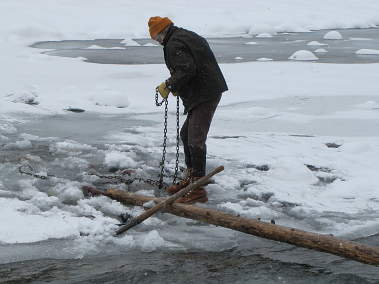 |
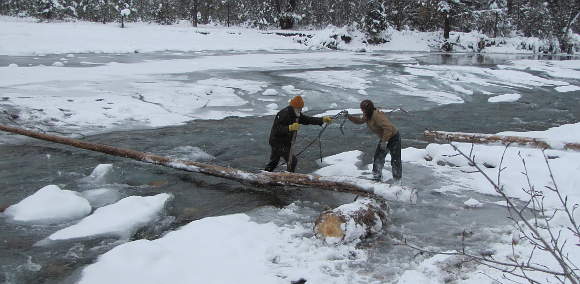 |
 |
Rule #1 is "Stay dry," so we rewrapped the chain higher up, then slid it down as far as we could, levered up the end of the log, and slid it some more.
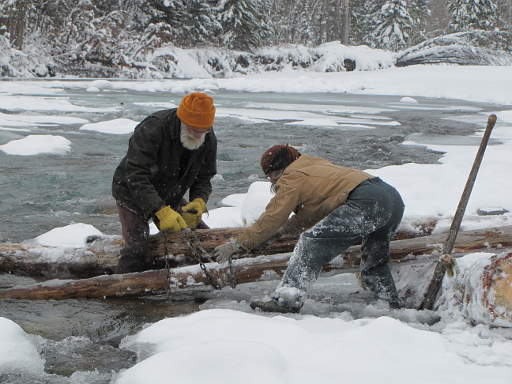 |
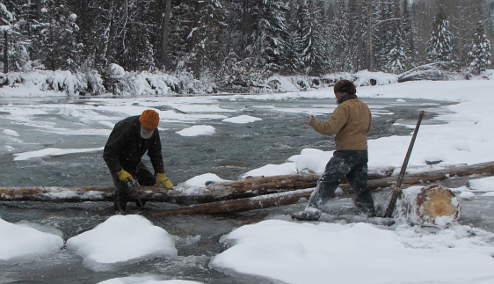 |
Fortunately, the log wasn't too heavy and was bouyed up some by the water. By running the chain over my knee I could get enough of an angle on it that it would ride up over the rocks in the channel. At least most of the way.
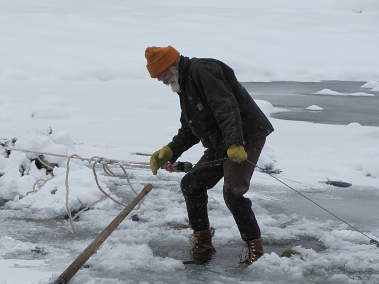 |
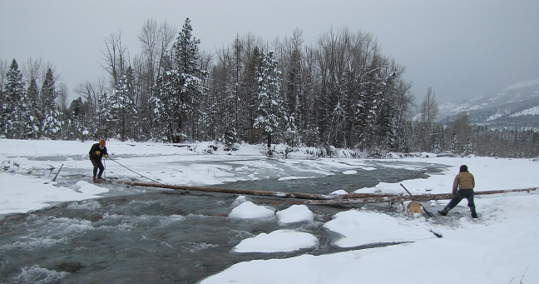 |
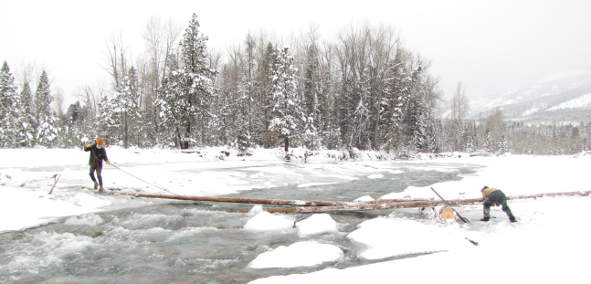 |
We slid the end up on the ice, scootched the two logs parallel, and Andrea worked her end up onto the log abutment.
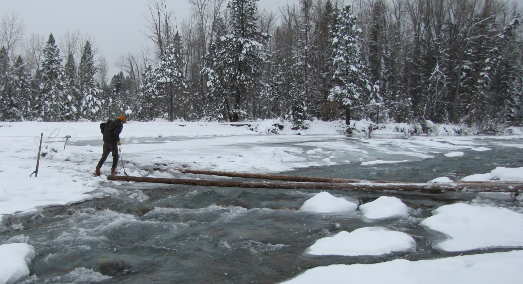 |
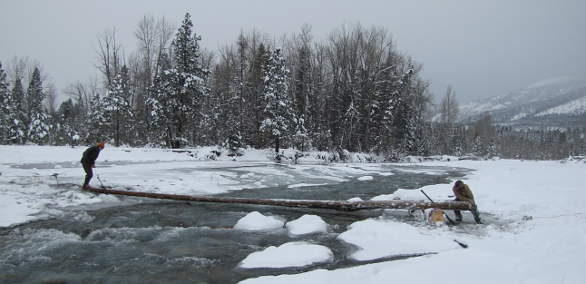 |
Voila! We had a bridge, of sorts. It still needed some decking, but for now it would suffice.
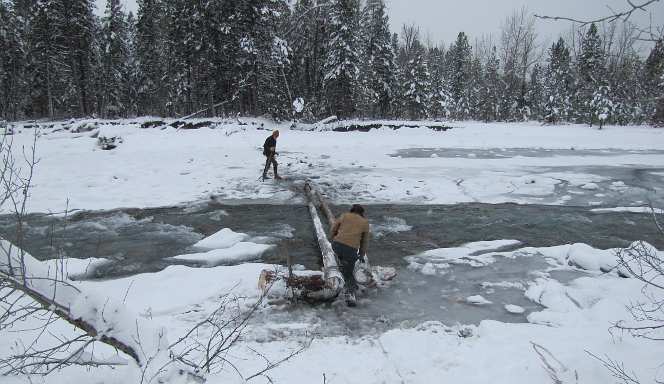 |
Andrea worked her way across the iced-up logs while I ferried the saw across.
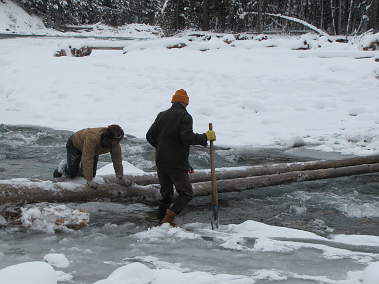 |
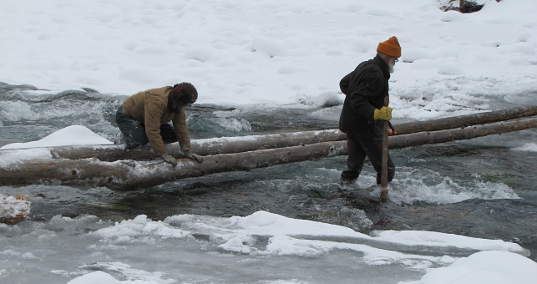 |
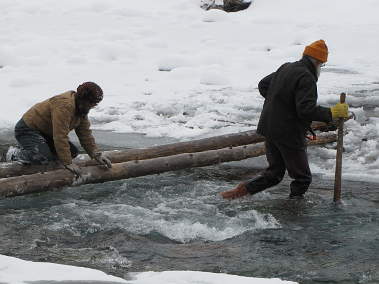 |
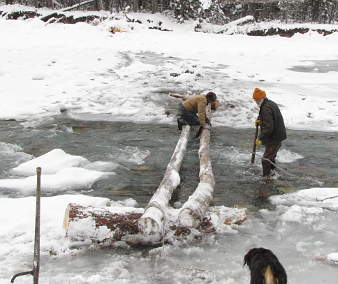 |
We cut a log to serve as an abutment and worked it under the logs on the far side, then gathered up our tools and headed back.
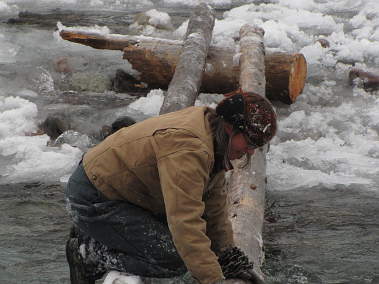 |
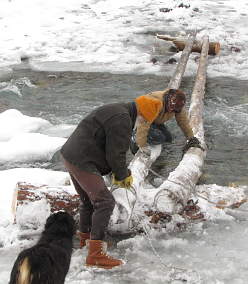 |
The far bank was basically a gravel bar, a new deposition from the high water this past spring. It had about four inches of ice and slushy snow on it, with water running underneath. When I walked on it while working, it caved in and I punched through. I tried to keep the come-along dry, as I was worried about ice building up in it and causing it not to work. But at least so far it had worked great.
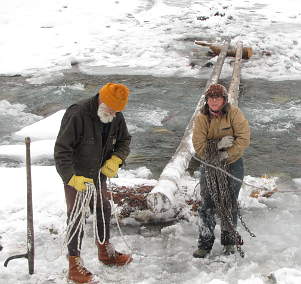 |
My main focus was to get the logs across the river, since I had Andrea to help out. So we left the deck for later. I put the deck on a few days later.
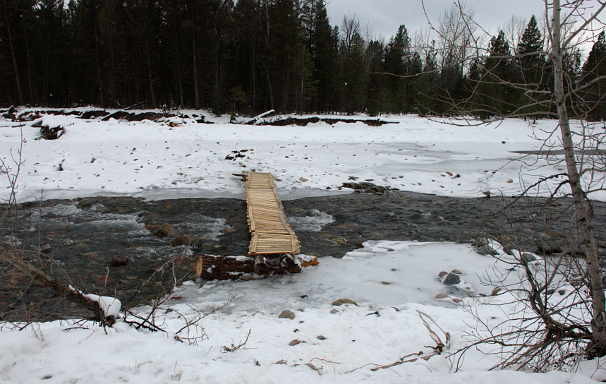 |
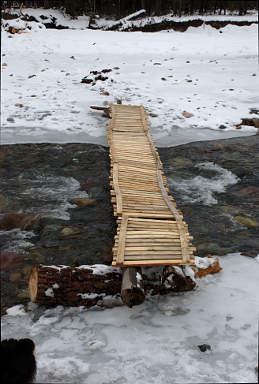 |
| Lower Ski Bridge, Completed |
After a warm-up at the house, we headed upriver to the location for the second bridge. For that one I only had one log ready, but it was a long one. I thought it was long enough to cut in two and still span the river. We measured it in peavey lengths, then used the saw to flatten / mark it at about the middle. Then we repeated the drill, with me going across and tieing the rope to an anchor, hooking the come-along to the chain attached to the butt of the log, and winching.
Unfortunately, by this time the temperature was down around 12F, and the comealong dogs were icing up. At first I tried using the point of the peavey to chip off ice and push them back and forth, but it was waaaay to big a lever. I found a stick that would work, but it was impossible to work the come-along very rapidly.
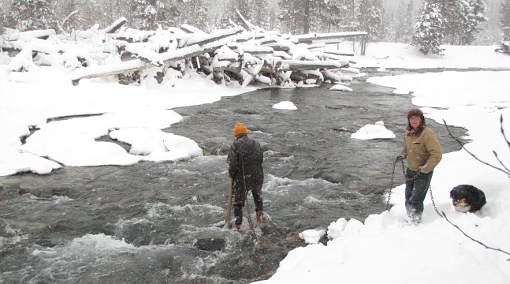 |
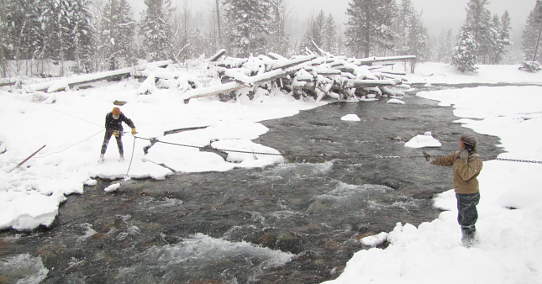 |
 |
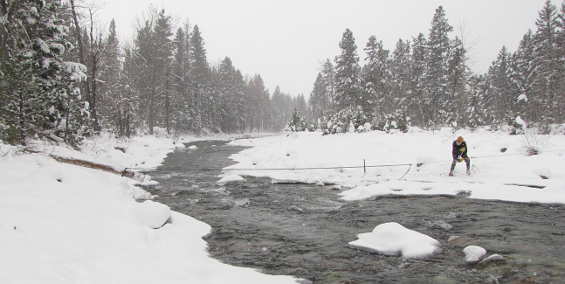 |
This log was pretty heavy, and the butt went down to the river and wanted to stay there. Andrea bounced on the far end and I pulled on my end with the come-along and we got it out to the middle of the river. What we needed was an 'A' frame to hang a snatch-block by on the far bank -- that way the pull would be more upwards. But that would take a while to fabricate, and Andrea had an appointment to get to. So I tightened up the come-along, then went out to the end of the log and pried it up with the peavey, and it slid some more. Working it that way we got it over to the far bank.
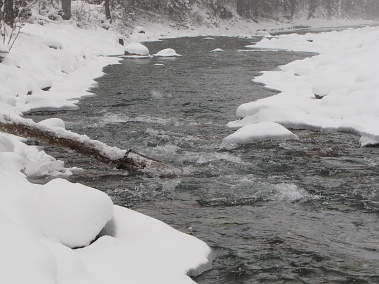 |
 |
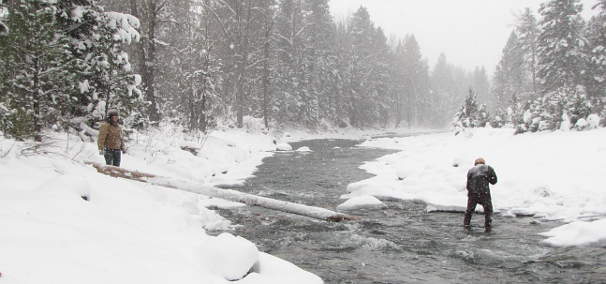 |
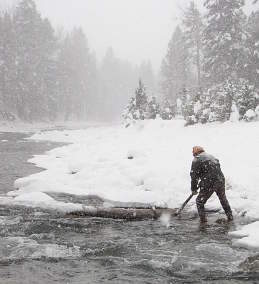 |
All that in and out of the water in way below freezing temperatures caused quite a build-up of ice on the bottoms of my boots. I had semi-fashionable platform shoes. How the heck do some women walk in those things all day? Why do some women walk in those things all day???
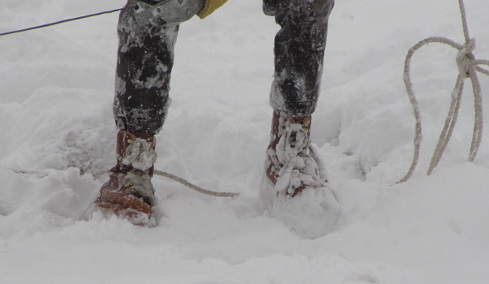 |
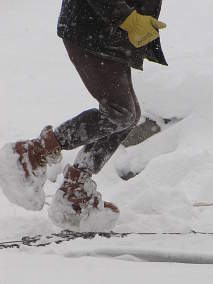 |
About that time the batteries in Dona's camera gave out. The log was barely long enough, when cut in half. I mis-calculated and had Andrea cut it six inches the wrong way, so the second log was shorther. Ugh. But it was long enough.
Unfortunately, the second piece of the log was a bit more of a problem. We tried to slide it across on the upstream side of the first log, which was stupid. The end, of course, got carried by the water under the first log, and we risked dislodging the first log if we continued trying to pull it across. Fortunately it was the light end of the log and we had a chain on the end of it. I waded out to where the end of the log was, on the downstream side of the first log, then using the peavey as a lever was able to get the end of the new log up on top of the first one. Then we slid it easily across the iced up log to the other side.
We propped the far end on some rocks, figuring mother nature would ice them in solidly.
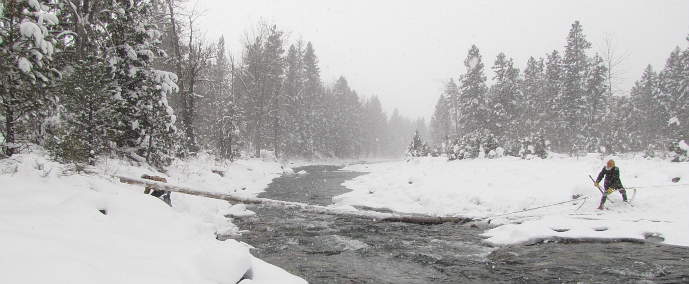 |
We had to stop for the day, as Andrea had to be someplace else.
A few days later, I built the decks for the bridges in sections, so I could ferry them up to the bridge on a kid's plastic sled, and so (hopefully) we can dis-assemble it in the spring before high water. Then I took them up and screwed them on.
I checked the upper bridge the next day and discovered it was too low on the far bank; it had a big ice build-up on the upstream edge. So I set about building up an abutment on the far bank. It would have been nice if the logs were about ten feet longer, but this is what we have, at least for this year. Once the abutment was done and things were more or less level, I declared the bridge ready for ski, snowshoe, and foot traffic. But it had warmed up, and there wasn't much snow left. And what there was was so wet it wasn't very good skiing. So now we're waiting for snow.
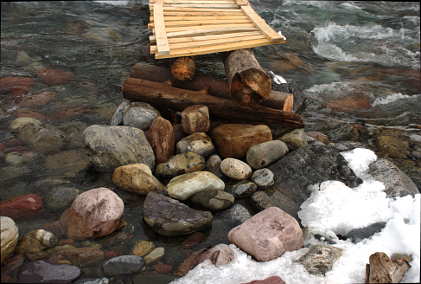 |
 |
| Makeshift Abutment | Finished Bridge |
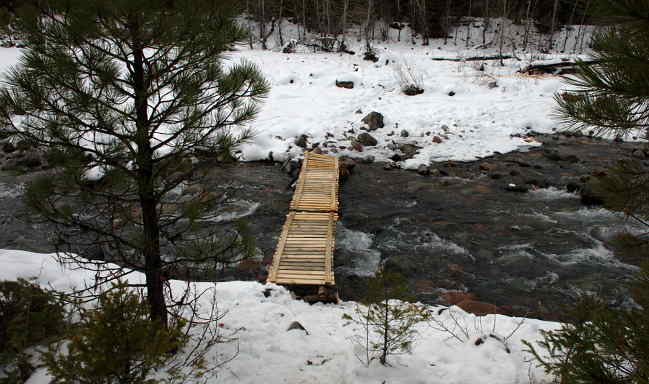 |
| Upper Ski Bridge, Completed |